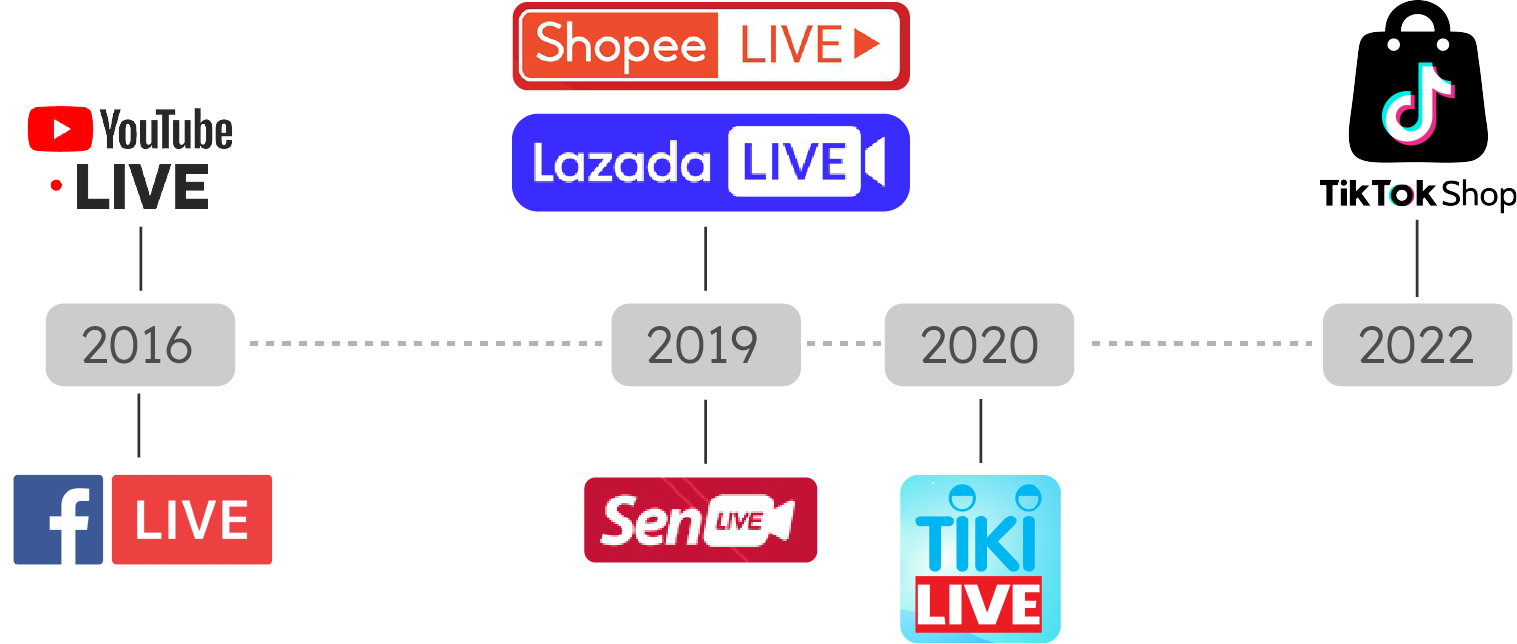When Le Thanh Van started his first livestream sessions in 2016, he was one of the first sellers to reach new customers through broadcasts.
“I decided to just do a live stream and have a casual chat with my customers,” he says.
“I was probably the first Vietnamese man to do a live stream selling women's clothes.”
At the time, the fashion company Van founded, GUMAC, was a small startup in Ho Chi Minh City, but realizing the potential of new sales methods, the CEO at the time began live streaming for 8 to 10 hours every day.
Some sessions were watched by hundreds of thousands of viewers, and his brand grew rapidly, allowing him to open 30 new stores within a year.
Van never dreamed that eight years later, social media live streaming would become one of the most successful marketing tools in Vietnam.

Timeline of live streaming services launched in Vietnam
Livestreaming first came to stores' attention when it became popular in China in 2016 after e-commerce giant Alibaba launched Taobao Live, a streaming platform that worked like a TV shopping site but allowed two-way, real-time interaction between sellers and buyers.
Taobao saw success in 2018, generating approximately US$14 million in sales through livestreams and videos, with 34% of viewers making a purchase.
“Vietnamese people quickly picked up on this trend,” said Chu Xuan Duc, chairman of digital media company DC Media Global.
Vendors leveraged their large social media following and turned Facebook Live into a distribution channel.
A typical livestream will have one or two sellers showcasing a number of products with discounts and mentioning the names of customers who have placed orders.
“I was obsessed with livestreaming,” said Van, who livestreamed three sessions a day for three years.
At one point, he vomited blood due to overwork.
Three years after Facebook Live was launched, e-commerce platforms started realizing the potential of livestreaming and created their own versions. Lazada was the first to make the move, followed by Shopee and Sendo.
But while these platforms made it easier to shop through livestreaming, they were unable to leverage Facebook's massive user base.
Reaching millions
TikTok sees opportunity In 2022, it launched a shoptainment feature called “TikTok Shop,” allowing merchants to reach millions of users through livestreaming.
Nguyen Lam Thanh, policy director at TikTok Vietnam, said the company's platform offers users a continuous experience where they don't need to leave the app to make purchases.
Business owners are also finding it much easier to sell via TikTok compared to traditional marketing platforms.
Nguyen Huong, founder of fashion brand GUNO, said: “Thanks to TikTok's livestreaming feature, my brand became so popular that sometimes I couldn't fulfill orders.”
A year after starting live streaming on TikTok, GUNO's monthly revenue soared 20-fold.
Within a few months, GUNO became one of the 10 best-selling vendors on TikTok Shop.
The most successful session attracted more than 3,000 viewers and saw the company sell products worth VND2 billion.
TikTok Shop now surpasses Lazada in terms of number of sellers and is Vietnam's second-largest e-commerce platform in terms of revenue after Shopee.
Duch said TikTok is able to retain users because it doesn't allow livestreams to be rewatched, meaning users miss out on discounts if they don't open the app.
The influence of reviewers and opinion leaders also plays a major role in increasing the popularity of live streaming.
Around 53% of Vietnamese consumers are influenced by online communities when making shopping decisions, and 86% would prefer to discover and purchase products on the same platform.
Trends for all brands
As livestreaming continues to grow, big Vietnamese brands have also felt the need to join the trend and have started selling expensive smartphones and TVs through the channel.
Between December 2023 and March 2024, more than 13,000 stores have opened on TikTok Shop, including FPT Shop, one of Vietnam's largest electronics retailers.
Nguyen The Kha, FPT's director of commerce, said the rise of shopatainment and changing shopping habits among young people are among the reasons FPT Shop is selling on social media.
Young people enjoy interacting directly with sellers through livestreams because it saves them time from having to go to a store, he said.
“Livestreaming is bringing about a big change in the e-commerce market,” said Pham Thao Linh, head of e-commerce for the consumer products division of L'Oreal Vietnam, Vietnam's largest cosmetics company.
While well-known brands have struggled to keep up with the changes, she said, there are examples of lesser known brands that have gained popularity in no time.
She added that big brands often have a lot of protocols about how they can promote their products and are less flexible in responding to social media trends.
Traditional businesses wanting to get into livestreaming often partner with opinion leaders and social media influencers, she said.
One business sold 1,000 items in two minutes during a livestream, which was unprecedented for the company, she said.
The new workforce
The rise of livestreaming and social media shopping is creating new jobs in Vietnam.
According to Duck, TikTok has more than 400,000 content creators, including a large number of “streamers” who host livestreams.
Pham Ngoc Duy Liem, co-founder of streaming service provider GoStream, said top streamers are earning between VND200 million and VND300 million per broadcast, including fees.
While many streamers work for legitimate companies, some have acknowledged using their live streams to sell counterfeit goods.
Nguyen Hong Son, a lecturer at Hanoi Law University, said streaming should be recognised as a job that requires a work permit so it can be regulated.
Story by Viet Duc and May Trinh
Graphics: Khanh Hoang, Thanh Ha


